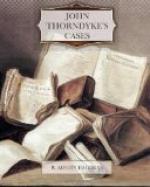[Illustration: The Sergeant’s Sketch
Extreme length, 113/4 inches.
Width at A, 41/2 inches.
Length of heel, 31/4 inches
Width of heel at cross, 3 inches.]
“Would you swear that the footprints were made with these shoes?” asked the coroner.
“No, sir, I would not,” was the decided answer. “I would only swear to the similarity of size and pattern.”
“Had you ever seen these shoes before you made the drawing?”
“No, sir,” replied the sergeant; and he then related the incident of the footprints in the soft earth by the pond which led him to make the arrest.
The coroner gazed reflectively at the shoes which he held in his hand, and from them to the drawing; then, passing them to the foreman of the jury, he remarked:
“Well, gentlemen, it is not for me to tell you whether these shoes answer to the description given by Dr. Burrows and the sergeant, or whether they resemble the drawing which, as you have heard, was made by the officer on the spot and before he had seen the shoes; that is a matter for you to decide. Meanwhile, there is another question that we must consider.” He turned to the sergeant and asked: “Have you made any inquiries as to the movements of the accused on the night of the murder?”
“I have,” replied the sergeant, “and I find that, on that night, the accused was alone in the house, his housekeeper having gone over to Eastwich. Two men saw him in the town about ten o’clock, apparently walking in the direction of Sundersley.”
This concluded the sergeant’s evidence, and when one or two more witnesses had been examined without eliciting any fresh facts, the coroner briefly recapitulated the evidence, and requested the jury to consider their verdict. Thereupon a solemn hush fell upon the court, broken only by the whispers of the jurymen, as they consulted together; and the spectators gazed in awed expectancy from the accused to the whispering jury. I glanced at Draper, sitting huddled in his chair, his clammy face as pale as that of the corpse in the mortuary hard by, his hands tremulous and restless; and, scoundrel as I believed him to be, I could not but pity the abject misery that was written large all over him, from his damp hair to his incessantly shifting feet.
The jury took but a short time to consider their verdict. At the end of five minutes the foreman announced that they were agreed, and, in answer to the coroner’s formal inquiry, stood up and replied:
“We find that the deceased met his death by being stabbed in the chest by the accused man, Alfred Draper.”
“That is a verdict of wilful murder,” said the coroner, and he entered it accordingly in his notes. The Court now rose. The spectators reluctantly trooped out, the jurymen stood up and stretched themselves, and the two constables, under the guidance of the sergeant, carried the wretched Draper in a fainting condition to a closed fly that was waiting outside.




